Located in the heart of Italy, Umbria has a very special position being the country’s only region that neither has a seacoast nor borders another country. The highly varied landscape is dominated by the Apennine with its highest mountain, Monte Vettoro, peaking at 2,478 m and the fertile valley around the headwaters of the River Tiber. The long, fascinating history, which started with the Umbri around 1200 BC and, slightly later, the Etruscans, has had its effects of the top 10 sights of Umbria your ZAINOO Italy experts have compiled for you.
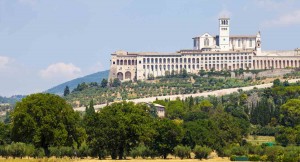
©Bigstock.com/Foto-Join
Basilica of Saint Francis of Assisi
Francis of Assisi wanted to find eternal peace at a place similar to the execution hill Golgotha outside Jerusalem’s city walls where Jesus Christ died. A basilica, to this day one of Italy’s most beautiful and important, was built on the “Hill of Hell”. Despite being sorely afflicted by severe earthquakes, it has always been rebuilt, and for good reason. The breathtakingly beautiful cycle of frescoes in the upper basilica depicts the life of the saint. It is located in the wide, tall main hall and is only one of many moving highlights in this unique sacral building.
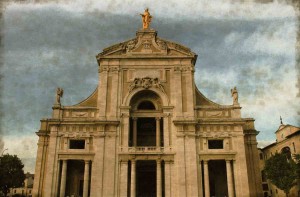
©Bigstock.com/Alessandro0770
Porziuncola near Assisi
One day Francis of Assisi discovered this abandoned chapel, which was first documented in 1045, in a holm oak forest about 3 km south of Assisi and decided to restore it using just his own bare hands. It is also where the Franciscan Order was founded. Francis of Assisi died in this chapel on 3 October 1225. Today, the Porziuncula, as the chapel Santa Maria degli Angeli is known more popularly, is embedded in the large basilica of the same name. Over the years it was adorned by artists. Look forward to many glorious frescoes harmonising with the old stones that were once carried here by the saint himself.
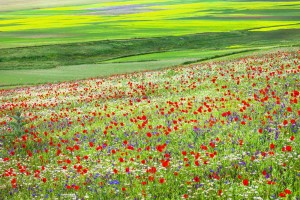
©Bigstock.com/Maugli-l
The colourful fields of Castelluccio di Norcia
Only around 150 people live in Castelluccio, a frazione of the commune Norcia, at an altitude of 1,452 m. The highest settlement of the Apennine borders the Monti Sibillini National Park and is known for its excellent cultivated landscape. The lentils growing here are treasured far across the region’s borders for their high quality. They thrive on the wide fields around the village that are figuratively plunged in variegated colours every spring. Let your gaze roam across red poppy flowers or yellow rapeseed – a fascinating sight you’ll never forget.
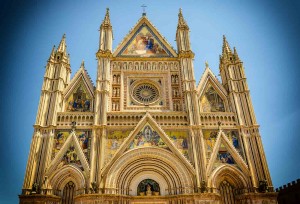
©Bigstock.com/marcorubino
Orvieto Cathedral
You can see the Cathedral of the Assumption of Mary located on a rock plateau from afar. It is one of many fascinating buildings planned around the late 13th century that still dominate the cityscape to this day. The fascinating, diligently adorned face of the cathedral with its reliefs, alcoves and portals is at least as impressive as the cycle of frescoes dedicated to the end of the world inside the building. Luca Signorelli’s figure-heavy, anatomically impressive depictions are regarded as an important part of Italy’s art history.
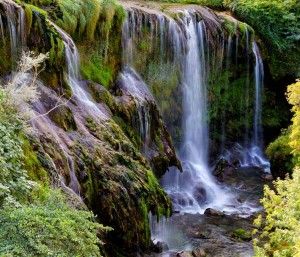
©Bigstock.com/Lenor
Cascata delle Marmore
Did you bring rain protection? You can certainly use it when nearing the Cascata delle Marmore. Marmore’s Falls, as they are known in English, are a three-part man-made waterfall at the end of the river Vellino and one of the highest of their kind in all of Italy. A 50 m long tunnel at the halfway mark of the waterfall trail brings you to the vantage point Balcone degli Innamorati (“Balcony of the Enamoured”). You can also hike to the vantage point Specola ordered in 1787 by Pope Pius VI. Look for white papal smoke!
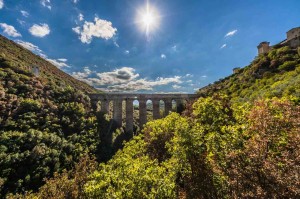
©Bigstock.com/vinciber
Ponte delle Torri near Spoleto
Find one of Italy’s largest aqueducts outside the city of Spoleto. It is widely assumed that Pope Innocent VI ordered construction of the Ponte delle Torri (Eng. “Bridge of Towers”) in mid-14th century. It also served as the city’s main source of water supply until the 19th century. The 230 m long and 76 m high bridge crosses the small river Tessino. While strolling over the Ponte delle Torri you’ll come across a small house around the halfway mark. Many centuries ago guards collected toll duties here. We wonder if Goethe, who was astonished by this aqueduct during his trip through Italy in 1786, had to pay up as well.
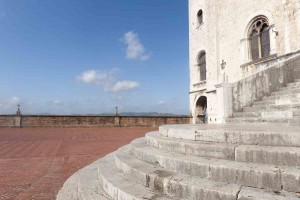
©Bigstock.com/Claudiogiovanni
Piazza Grande in Gubbio
When arriving in the heart of city of Gubbio built on hillslopes in north-eastern Umbria, you’re immediately drawn to Piazza Grande featuring some of the town’s most beautiful buildings. Palazzo dei Consoli was virtually built into the air making optimum use of its rather extreme location. Among other things, it houses a small museum. The nobility houses located opposite the palace originated from the connection of several old buildings. Palazzo Pretorio, planned by the city’s main architect Gattapone, who also planned Palazzo dei Consoli, today houses the town hall.
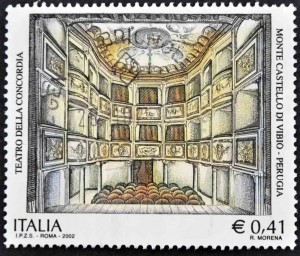
©Bigstock.com/Neftali
Teatro della Concordia in Monte Castello di Vibio
In the early 19th century, as Napoleon’s troops were occupying the country, nine wealthy families from Monte Castello di Vibio wanted a theatre supporting the ideals of the French Revolution – freedom, equality and brotherhood. The uniquely bell-shaped Teatro della Concordia (“Theatre of Union”) is the smallest theatre all’italiana of the world with only 99 seats and a 50 m² large stage. What’s really impressive about the ceiling fresco is that the artist was only 15 years old when he made it. The theatre is still in use for regular performances.
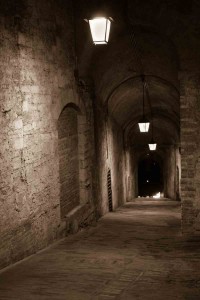
©Bigstock.com/SimoneNuform
Rocca Paolina in Perugia
Pope Paul III defeated Perugia’s inhabitants, who refused to accept the new tax on salt, in the so-called Salt War in 1540. He had the fortification site Rocca Paolina, which was named after him, built to keep firm control of the city turning the Rocca into a symbol of oppression by the Papal States. The massive walls made from over a hundred demolished buildings, churches and abbeys once housed a papal palace. Now it holds an escalator transporting you into the city centre. This mechanical path running alongside old walls is as spooky as it is impressive.
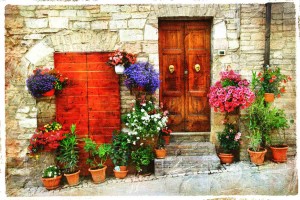
©Bigstock.com/Maugli-l
L’infiorata di Spello
If you visit Umbria between late May and mid-June, you need to make a trip to Spello, which is where the colourful festival L’infiorata takes place on the weekend of the Feast of Corpus Christi. The town’s inhabitants create artful pictures by putting millions of blossoms on the streets on the night from Saturday to Sunday. They cover at least 24 m² lining the path of the bishop through the historic city centre. You have to see this!
Uniting fascinating scenery, witnesses of eventful history and the most important stages of the life of Francis of Assisi, the top 10 sights of Umbria invite you to go on an astonishing round trip through this region in the heart of Italy. Find even more holiday suggestions on the website of ZAINOO!